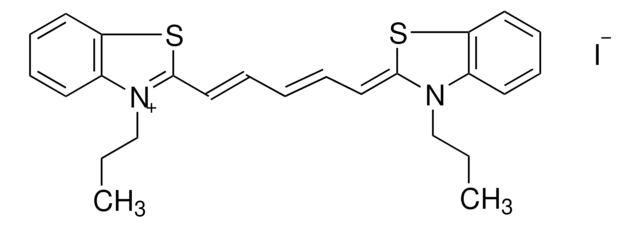推荐产品
化驗
98%
形狀
crystalline powder
mp
288 °C (dec.) (lit.)
溶解度
chloroform/methanol: 10 mg/mL, clear
λmax
559 nm
&epsilon ;(消光係數)
163120 at 599 nm in methanol at 0.00463 g/L
17425 at 298 nm in methanol at 0.00463 g/L
40246 at 220 nm in methanol at 0.00463 g/L
螢光
λex 559 nm; λem 575 nm in methanol
應用
diagnostic assay manufacturing
hematology
histology
儲存溫度
room temp
SMILES 字串
[I-].CCCN1C(\Sc2ccccc12)=C\C=C\c3sc4ccccc4[n+]3CCC
InChI
1S/C23H25N2S2.HI/c1-3-16-24-18-10-5-7-12-20(18)26-22(24)14-9-15-23-25(17-4-2)19-11-6-8-13-21(19)27-23;/h5-15H,3-4,16-17H2,1-2H3;1H/q+1;/p-1
InChI 密鑰
JGTCEHAVVINOPG-UHFFFAOYSA-M
正在寻找类似产品? 访问 产品对比指南
一般說明
應用
生化/生理作用
訊號詞
Warning
危險聲明
危險分類
Eye Irrit. 2 - Skin Irrit. 2 - STOT SE 3
標靶器官
Respiratory system
儲存類別代碼
11 - Combustible Solids
水污染物質分類(WGK)
WGK 3
閃點(°F)
Not applicable
閃點(°C)
Not applicable
個人防護裝備
dust mask type N95 (US), Eyeshields, Gloves
其他客户在看
我们的科学家团队拥有各种研究领域经验,包括生命科学、材料科学、化学合成、色谱、分析及许多其他领域.
联系技术服务部门









